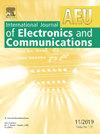Unsupervised surrogate-assisted synthesis of free-form planar antenna topologies for IoT applications
IF 3.2
3区 计算机科学
Q2 ENGINEERING, ELECTRICAL & ELECTRONIC
Aeu-International Journal of Electronics and Communications
Pub Date : 2025-08-12
DOI:10.1016/j.aeue.2025.155997
引用次数: 0
Abstract
Design of antenna structures for Internet of Things (IoT) applications is a challenging problem. Contemporary radiators are often subject to a number of electric and/or radiation-related requirements, but also constraints imposed by specifics of IoT systems and/or intended operational environments. Conventional approaches to antenna design typically involve manual development of topology intertwined with its tuning. Although proved useful, the approach is prone to errors and engineering bias. Alternatively, geometries can be generated and optimized without supervision of the designer. The process can be controlled by suitable algorithms to determine and then adjust the antenna geometry according to the specifications. Unfortunately, automatic design of IoT radiators is associated with challenges such as determination of desirable geometries or high optimization cost. In this work, a variable-fidelity framework for performance-oriented development of free-form antennas represented using the generic simulation models is proposed. The method employs a surrogate-assisted classifier capable of identifying a suitable radiator topology from a set of automatically generated (and stored for potential re-use) candidate designs. The obtained geometry is then subject to a bi-stage tuning performed using a gradient-based optimization engine. The presented framework is demonstrated based on six numerical experiments concerning unsupervised development of bandwidth-enhanced patch antennas dedicated to work within 5 GHz to 6 GHz and 6 GHz to 7 GHz bands, respectively. Extensive benchmarks of the method, as well as the generated topologies are also performed.
物联网应用中自由形式平面天线拓扑的无监督代理辅助合成
物联网(IoT)应用的天线结构设计是一个具有挑战性的问题。现代散热器通常受到许多电气和/或辐射相关要求的约束,但也受到物联网系统和/或预期操作环境的具体限制。传统的天线设计方法通常涉及人工开发与其调谐交织在一起的拓扑。虽然被证明是有用的,但这种方法容易出现错误和工程偏差。另外,几何图形可以在没有设计人员监督的情况下生成和优化。该过程可以通过适当的算法来控制,以确定然后根据规格调整天线的几何形状。不幸的是,物联网散热器的自动设计面临着诸如确定理想几何形状或高优化成本等挑战。在这项工作中,提出了一个可变保真度框架,用于使用通用仿真模型表示的面向性能的自由形式天线的开发。该方法采用代理辅助分类器,能够从一组自动生成(并存储以供潜在重用)的候选设计中识别合适的散热器拓扑。然后使用基于梯度的优化引擎对获得的几何图形进行双阶段调优。该框架基于6个数值实验,分别用于5 GHz至6 GHz和6 GHz至7 GHz频段的带宽增强贴片天线的无监督开发。还执行了该方法的广泛基准测试以及生成的拓扑。
本文章由计算机程序翻译,如有差异,请以英文原文为准。
求助全文
约1分钟内获得全文
求助全文
来源期刊
CiteScore
6.90
自引率
18.80%
发文量
292
审稿时长
4.9 months
期刊介绍:
AEÜ is an international scientific journal which publishes both original works and invited tutorials. The journal''s scope covers all aspects of theory and design of circuits, systems and devices for electronics, signal processing, and communication, including:
signal and system theory, digital signal processing
network theory and circuit design
information theory, communication theory and techniques, modulation, source and channel coding
switching theory and techniques, communication protocols
optical communications
microwave theory and techniques, radar, sonar
antennas, wave propagation
AEÜ publishes full papers and letters with very short turn around time but a high standard review process. Review cycles are typically finished within twelve weeks by application of modern electronic communication facilities.

 求助内容:
求助内容: 应助结果提醒方式:
应助结果提醒方式:


